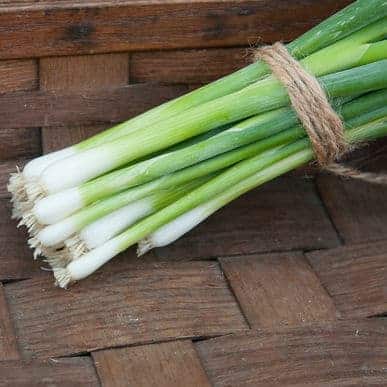Parade | Organic Spring Onion Seed
SCIENTIFIC NAME: Allium fistulosum.
CULTURE: Seed can be sown in early spring for summer use, and in January or February for autumn and spring . Bunching onions prefer a soil with a pH of 6.2-6.8. Extra-hardy varieties will normally survive the winter if the soil is well drained.
MICRO-FARMING SPECIFICATIONS:
30metre permabed : Rows; 5, Spacing in the row; 15cm, Days; 70 Harvest days; 14, Total days in garden; 34, Days in cells; 50, Bunches / bed; 500, $2.00 Bunch $1000.00 +/- 9 onions by grabbing 2 clumps/bunch.
INTENSIVE SPACING:5 rows 15cm, spaced every 15cm on the row.
FERTILISING: Spring onions will do great in beds that were previously amended with compost and
fertilized with a mix of alfalfa meal (2-0-2) and pelleted chicken manure (5-3-2).
IRRIGATION:
Irrigation Type; Drip tape or Techline, (4 per bed) or sprinkler, although over head irrigation can increase foliar disease.
Irrigation Management; Root depth: Shallow.
General: Steady supply of moisture; if too dry, onions get a strong unpleasant flavor.
Avoid water on leaves to minimize downy mildew.
IMPLANTATION:
Spring onions (Scallions) onions are one of the most reliable crops. Easy to grow, consistently popular
and they generate a good revenue per bed planted. We plant some every 2 weeks to
ensure a constant supply throughout the season. For every seeding, we plan enough
beds for an estimated 3 weeks of supply.
In our planting program, spring onions are grouped with crops like lettuce, rapini, bok choy, mini-romaine, mini-fennel, dill, cilantro and mini-kohlrabi, all crops that stay in the fields +/- 50 days and that have similar crop requirements.
EQUIPMENT:
Rotary harrow
75cm bed prep rake
Popping tray and marking roller.
ITINERARY:
Remove tarp and clean out large debris. Use the rake if needed. *
Uniformly apply amendments and pass with the rotary harrow at a depth of 5cm. To make transplanting easier (seeing as the soil is loose after being harrowed), we only prepare the beds when we are about to transplant.
Pass with the dibbler-roller to mark the planting holes and bring out the well-watered trays.
Once the beds are ready, 1 person will drop the seedlings while 2 others transplant
the plants as fast as possible making sure that at least 3-4 onions are dropping (if
not, combine plugs). 3 people/30metre bed is good ratio for efficient work-flow.
Install irrigation and water until the soil is deeply moistened.
* If the previous crop is too well established, or if the bed is too messy, mow the crop as low as possible and harrow at a depth of 5cm. Add 2.5cm of compost evenly spread on the whole wilih of the bed and transplant into compost following a no-till strategy.
WEEDING: 10-14days after transplanting, use the bio disc to cultivate on the row and between the rows in one single pass.
PLANT PROTECTION: No action is required.
HARVEST:
Spring onions are harvested with their tops and bunched in the fields in a kneeled position.
Onions are picked when they sized up between 10-12 cm. Bottoms should be white, without any dead leaves?make sure to strip off any leaves that are crushed, or have signs of rip damage.
Make bunches of +/- 9 onions by grabbing 2 clumps and tying them with a rubber band. Shake off excess soil and make piles of 10 bunches in the aisles.
1 person should harvest at least 60 bunches/hour.
CONDITIONING:
Spring onions are washed using a pressure gun. Upon arriving from the fields, the bins are transferred to the cart and placed to the left of the sinks.
A lot of bunches are placed side by side with the roots facing the operator. The operator then sprays the soil off with the gun. Turn the bunches over and repeat. Then pile to the right.
Once the pile has reached a certain height, put in storage bin and identify the bin.
1 person should package at least 100 bunches per hour.
STORING: Spring onions are stored in cold room kept at 2C.
DIRECT SEEDING: Sow 6mm apart in rows of 5-7mm wide bands, 6-12mm deep. Thin to about an 2.5cm apart only if large diameter is needed. Keep well cultivated so that plants receive maximum light.
TRANSPLANTING: For negi-style scallions with a thicker blanched portion, start in flats. Then, beginning in late spring, when 20-45cm tall and pencil-thick, transplant outdoors 15cm apart, rows 60cm apart in holes dibbled about 15cm deep. Only 2.5-5cm of leaves need extend above the soil surface. Do not firm soil, allow irrigation or rain to fill in the dibble hole.
BLANCHING: During the growing period hill the plants with soil 2 or 3 times, higher with each hoeing. This forces the leaves higher up the plant resulting in extra-long blanched stalks and a much greater edible portion. When using the “dibble method”, hilling is reduced or eliminated.
HARVEST: Loosen with fork or and gather. Wash, hydrocool, and hold at near freezing until shipped or displayed.
AVG. DIRECT SEEDING RATE: 30g/80metres, 120g./300m, 500g/1.2km, 3kg/acre at 50 seeds/30cm in 5cm wide bands 45cm apart.
SEED SPECS: Seeds/500g: Avg. 155,000.
Paperpot Transplanter: 15cm chainpots.
Paperpot Batch seeder: 4.5mm plate,
Jang JP seeder wheel: X-24 Gear setting, 13Front 10Back
Quick Facts
- Latin Name: Allium fistulosum
- Days To Maturity: 65 Days
- Life Cycle: Annual
- Certified Organic: MOFGA







